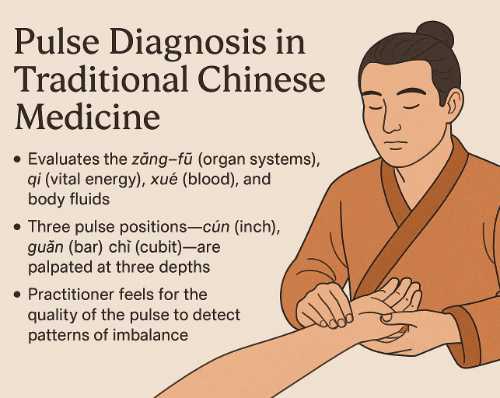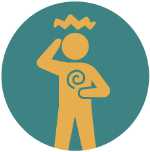Understanding Pulse Diagnosis
in Traditional Chinese Medicine
In Traditional Chinese Medicine (TCM), the pulse is far more than a heartbeat—it is a window into the state of the entire body. Pulse diagnosis (mài zhěn 脉诊) is one of the most refined diagnostic tools in the TCM practitioner’s repertoire, used for centuries to assess internal conditions without the need for modern instruments. Rather than simply measuring pulse rate or rhythm as in Western medicine, TCM examines the quality of the pulse to gather detailed information about the body’s zàng-fǔ (organ systems), the strength and flow of qì (vital energy), and the condition of xué (blood) and body fluids.
Pulse Diagnosis Q&A
Q: Do they really feel the pulse of each organ?
A: Not in the anatomical sense. The organs in TCM are energetic systems, not just physical structures. Each pulse position reflects the condition of a particular organ system, as understood in TCM theory—not the organ as seen in Western anatomy.
Q: Does it hurt?
A: Not at all. The practitioner uses gentle fingertip pressure, and many people find the experience calming or meditative.
Q: Why does the practitioner press at different depths?
A: Each depth corresponds to a different layer of the body: the superficial level often reflects external conditions like colds, the middle level relates to qi and organ function, and the deep level reveals more chronic or internal imbalances.
Q: Can they really tell what’s wrong just by feeling the pulse?
A: Pulse diagnosis is one piece of the larger diagnostic picture. It offers valuable insights but is always combined with other observations like tongue diagnosis and symptom inquiry for a more complete understanding.
Q: What should I do to prepare?
A: Try to be relaxed and avoid stimulants like coffee before your visit. Let your practitioner know if you’ve just eaten, exercised, or are feeling especially emotional—these factors can influence the pulse.
The Theory Behind It
Pulse diagnosis rests on a foundation of holistic theory. Each wrist contains three pulse positions—cùn (inch), guàn (bar), and chǐ (cubit's length)—and each of these positions is felt at three depths: superficial, middle, and deep. This creates a layered system through which a trained practitioner can assess the balance or imbalance in different organ systems. For example, the left wrist might reflect the Heart, Liver, and Kidney (yin), while the right wrist corresponds to the Lung, Spleen, and Kidney (yang). It’s important to understand these aren’t physical locations of organs but rather energetic correspondences.
There are traditionally 28 pulse qualities described in classical texts, with poetic names like slippery, thready, wiry, or choppy. Each has its own implication—perhaps a sign of heat, cold, excess, deficiency, or stagnation. A floating and rapid pulse might suggest an external wind-heat invasion (a cold or flu), while a deep, weak pulse may indicate internal deficiency.
What Practitioners Feel For
When a practitioner takes your pulse, they are not just counting beats. They are listening—through their fingers—for signs of harmony or disharmony. They will usually use three fingers (index, middle, and ring) placed along the radial artery of each wrist, pressing gently to varying depths. The patient should be relaxed, with both arms at heart level, ideally in a quiet setting. Factors like stress, recent meals, caffeine, or even the weather can influence the pulse, so context matters.
Practitioners combine what they feel with other diagnostic methods such as tongue observation, inquiry, and palpation of other body areas to build a complete picture. Pulse diagnosis is both an art and a science—refined over years of practice and difficult to master quickly.
What to Expect as a Patient
From the outside, having your pulse taken in TCM looks very much like a gentle, prolonged check of your wrist. But for the practitioner, it’s a moment of deep focus. You may notice them closing their eyes to concentrate, subtly shifting pressure or finger placement. It usually takes a few minutes per wrist. There’s no discomfort—in fact, many patients find it soothing.
Most importantly, pulse diagnosis is not about isolating one problem or organ. It’s about detecting patterns. In TCM, the body is a dynamic whole, and the pulse provides a living map of its balance, flow, and resilience.





